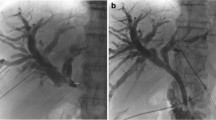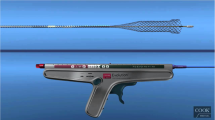Abstract
To compare clinical effectiveness of Viabil-covered stents versus uncovered metallic Wallstents, for palliation of malignant jaundice due to extrahepatic cholangiocarcinoma, 60 patients were enrolled in a prospective and randomized study. In half of the patients a bare Wallstent was used, and in the other half a Viabil biliary stent. Patients were followed up until death. Primary patency, survival, complication rates, and mean cost were calculated in both groups. Stent dysfunction occurred in 9 (30%) patients in the bare stent group after a mean period of 133.1 days and in 4 (13.3%) patients in the covered stent group after a mean of 179.5 days. The incidence of stent dysfunction was significantly lower in the covered stent group (P = 0.046). Tumor ingrowth occurred exclusively in the bare stent group (P = 0.007). Median survival was 180.5 days for the Wallstent and 243.5 days for the Viabil group (P = 0.039). Complications and mean cost were similar in the two groups. Viabil stent-grafts proved to be significantly superior to Wallstents for the palliation of malignant jaundice due to extrahepatic cholangiocarcinoma, with comparable cost and complication rates. Appropriate patient selection should be performed prior to stent placement.




Similar content being viewed by others
References
Parker SL, Tong T, Bolden S et al (1996) Cancer statistics CA. Cancer J Clin 46:5–27
Nakeeb A, Pitt HA, Sohn TA et al (1996) Cholangiocarcinoma: a spectrum of intrahepatic, perihilar, and distal tumors. Ann Surg 224:463–473
Ishak KG, Anthony PP, Sobin LH (1994) Histological typing of tumors of the liver. World Health Organization, Springer-Verlag, Berlin, pp 37–45
Carriaga MT, Henson DE (1995) Liver, gallbladder, extrahepatic bile ducts, and pancreas. Cancer 75:171–190
Shaib Y, El-Serag HB (2004) The epidemiology of cholangiocarcinoma. Semin Liver Dis 24:115–125
Lee KH, Lee DY, Kim KW (2004) Biliary intervention for cholangiocarcinoma. Abdom Imaging 29:581–589
Hatzidakis A, Adam A (2003) The interventional radiological management of cholangiocarcinoma. Clin Radiol 58:91–96
Chahal P, Baron T (2006) Endoscopic palliation of cholangiocarcinoma. Curr Opin Gastroenterol 22:551–560
Kaassis M, Boyer J, Dumas R et al (2003) Plastic or metal stents for malignant stricture of the common bile duct? Results of a randomized prospective study. Gastrointest Endosc 57:178–182
Rossi P, Bezzi M, Salvatori FM et al (1997) Clinical experience with covered Wallstents for biliary malignancies: 23-month follow-up. CardioVasc Interv Radiol 20:441–447
Hausegger KA, Thurnher S, Bodendorfer G et al (1998) Treatment of malignant biliary obstruction with polyurethane covered Wallstents. AJR Am J Roentgenol 170:403–408
Miyayama S, Matsui O, Terayama T et al (1997) Covered Gianturco stents for malignant biliary obstruction: preliminary clinical evaluation. J Vasc Interv Radiol 8:641–648
Han YM, Jin GY, Lee S et al (2003) Flared polyurethane-covered self expandable nitinol stent for malignant biliary obstruction. J Vasc Interv Radiol 14:1291–1301
Kanasaki S, Furukawa A, Kane T et al (2000) Polyurethane-covered nitinol Strecker stents as primary palliative treatment of malignant biliary obstruction. CardioVasc Interv Radiol 23:114–120
Isayama H, Komatsu Y, Tsujino T et al (2002) Polyurethane-covered metal stent for management of distal malignant biliary obstruction. Gastrointest Endosc 55:366–370
Isayama H, Komatsu Y, Tsujino T et al (2004) A prospective randomized study of “covered” versus “uncovered” diamond stents for the management of distal malignant biliary obstruction. Gut 53:729–734
Schoder M, Rossi P, Uflacker R et al (2002) Malignant biliary obstruction: treatment with ePTFE/FEP-covered endoprostheses-initial technical and clinical experiences in a multicenter trial. Radiology 225:35–42
Bezzi M, Zolovkins A, Cantisani V et al (2002) New ePTFE/FEP-covered stent in the palliative treatment of malignant biliary obstruction. J Vasc Interv Radiol 13:581–589
Hatzidakis A, Krokidis M, Kalbakis K et al (2007) ePTFE/FEP-covered metallic stents for palliation of malignant biliary disease: Can tumor ingrowth be prevented? Cardiovasc Interv Radiol 30:950–958
Fanelli F, Orgera G, Bezzi M et al (2008) Management of malignant biliary obstruction: Technical and clinical results using an expanded polytetrafluoroethylene fluorinated ethylene propylene (ePTFE/FEP)-covered metallic stent after 6-year experience. Eur Radiol 18(5):911–919
WHO (1979) WHO handbook for reporting results of cancer treatment. World Health Organization, Geneva
Kuo MD, Lopresti DC, Gover DD et al (2006) Intentional retrieval of viabil stent-grafts from the biliary system. J Vasc Interv Radiol 17:389–397
Sacks D, McClenny TE, Cardella JF et al (2003) Society of Interventional Radiology clinical practice guidelines. J Vasc Interv Radiol 14:199–202
Kaplan EL, Meier P (1958) Nonparametric estimation from incomplete observations. J Am Stat Assoc 53:457–481
Nakajima T, Kondo Y, Miyazaki M et al (1988) A histopathologic study of 102 cases of intrahepatic cholangiocarcinoma: histologic classification and mode of spreading. Hum Pathol 19:1228–1234
De Groen PC, Gores GJ, LaRusso NF et al (1999) Biliary tract cancers. N Engl J Med 341:1368–1378
Yamamoto M, Takasaki K, Yoshikawa T et al (1998) Does gross appearance indicate prognosis in intrahepatic cholangiocarcinoma? J Surg Oncol 69:162–167
Isaji S, Kawarada Y, Taoka H et al (1999) Clinicopathological features and outcome of hepatic resection for intrahepatic cholangiocarcinoma in Japan. J Hepatobiliary Pancreat Surg 6:108–116
Tsao JI, Nimura Y, Kamiya J et al (2000) Management of hilar cholangiocarcinoma: comparison of an American and a Japanese experience. Ann Surg 232:166–174
Cameron JL, Pitt HA, Zinner MJ et al (1990) Management of proximal cholangiocarcinomas by surgical resection and radiotherapy. Am J Surg 159:91–98
Bismuth H, Nakache R, Diamond T (1992) Management strategies in resection for hilar cholangiocarcinoma. Ann Surg 215:31–38
Baer HU, Stain SC, Dennison AR et al (1993) Improvements in survival by aggressive resections of hilar cholangiocarcinoma. Ann Surg 217:20–27
Allen PJ, Reiner AS, Gonen M et al (2008) Extrahepatic cholangiocarcinoma: a comparison of patients with resected proximal and distal lesions. HPB (Oxford) 10:341–346
Nakeeb A, Tran KQ, Black MJ et al (2002) Improved survival in resected biliary malignancies. Surgery 132:555–563
Prat F, Chapat O, Ducot B et al (1998) Predictive factors for survival of patients with inoperable malignant distal biliary strictures: a practical management guideline. Gut 42:76–80
Kahaleh M, Tokar J, Conaway MR et al (2005) Efficacy and complications of covered Wallstents in malignant distal biliary obstruction. Gastrointest Endosc 61:528–533
Krokidis ME, Hatzidakis AA, Manousaki EG et al (2008) Late migration of two covered biliary stents through a spontaneous bilioenteric fistula in a patient with malignant biliary obstruction. Cardiovasc Interv Radiol 31:222–225
Tham TC, Carr-Locke DL, Vandervoort J et al (1998) Management of occluded biliary Wallstents. Gut 42:703–707
Lammer J, Hausegger KA, Fluckiger F et al (1996) Common bile duct obstruction due to malignancy: treatment with plastic versus metal stents. Radiology 201:167–172
Author information
Authors and Affiliations
Corresponding author
Rights and permissions
About this article
Cite this article
Krokidis, M., Fanelli, F., Orgera, G. et al. Percutaneous Treatment of Malignant Jaundice Due to Extrahepatic Cholangiocarcinoma: Covered Viabil Stent Versus Uncovered Wallstents. Cardiovasc Intervent Radiol 33, 97–106 (2010). https://doi.org/10.1007/s00270-009-9604-9
Received:
Revised:
Accepted:
Published:
Issue Date:
DOI: https://doi.org/10.1007/s00270-009-9604-9




